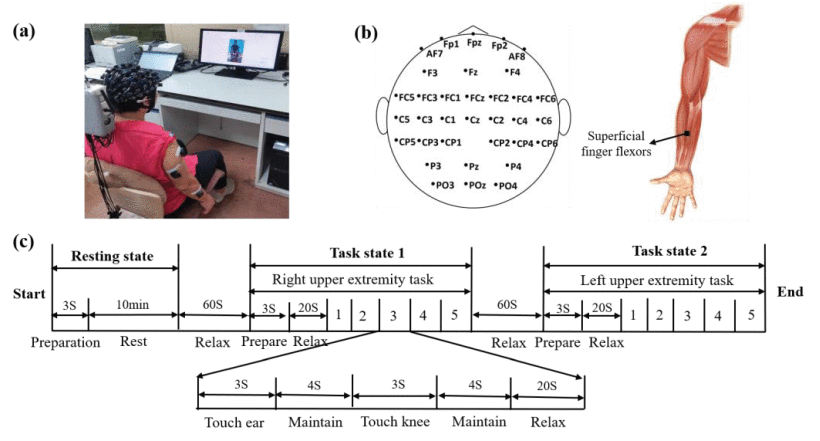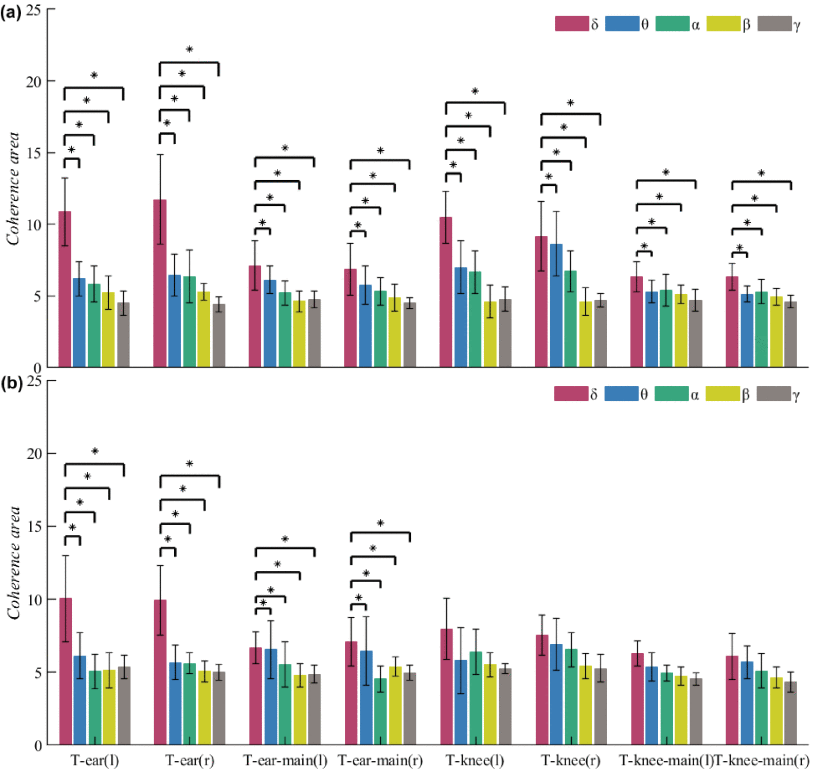


Ping Xie, Ying Wang, Jian Yu, Yan Lv, Shengcui Cheng, Yingying Hao, Xiaoling Chen, Tengyu Zhang, Jie Chen
Motor control is a complex process of coordination and information interaction among neural, motor, and sensory functions. Investigating the correlation between motor-physiological information helps to understand the human motor control mechanisms and is important for the assessment of motor function status. In this manuscript, we investigated the differences in the neuromotor coupling analysis between healthy controls and stroke patients in different movements. We applied the corticokinematic coherence (CKC) function between the electroencephalogram (EEG) and acceleration (ACC) data. First, we collected the EEG and ACC data from 10 healthy controls and 10 stroke patients under the task of movement execution (ear touch and knee touch) and movement maintenance (ear touch and knee touch). After the preprocessing of raw data, we used frequency domain coherence method to analyze the full-frequency EEG and ACC data, which could be concluded that the CKC intensity in the movement execution was higher than that in the movement maintenance. However, there was no significant difference between healthy subjects and stroke patients. Secondly, the coherence results in local frequency bands showed that low-frequency bands could better reflect the difference between movement execution and maintenance. The intensity of coherence in healthy subjects was significantly higher than that in other bands, but not in stroke patients. Further comparison of coherence results in local frequency bands showed that the intensity of theta band in healthy controls was significantly higher than other rhythms, especially in the knee touch phase. Therefore, we infer that neurodynamic coupling analysis based on EEG and ACC data can show the differences between healthy subjects and stroke patients. Such researches could add to the understanding of neuro-motor control mechanisms and provide new quantitative indicators on the motor function assessment.
运动控制是神经、运动和感觉功能之间协调和信息交互的复杂过程。研究运动-生理信息之间的相关性有助于了解人类的运动控制机制,对评估运动功能状态具有重要意义。在本手稿中,我们研究了健康对照组和脑卒中患者在不同运动中神经运动耦合分析的差异。我们在脑电图(EEG)和加速度(ACC)数据之间应用了皮质运动学相干(CKC)函数。首先,我们收集了 10 名健康对照组和 10 名脑卒中患者在动作执行(触耳和触膝)和动作维持(触耳和触膝)任务下的脑电图和加速度(ACC)数据。在对原始数据进行预处理后,我们使用频域相干法对全频脑电图和 ACC 数据进行了分析,结果表明,运动执行时的 CKC 强度高于运动维持时的 CKC 强度。然而,健康受试者与脑卒中患者之间并无明显差异。其次,局部频段的相干性结果显示,低频段更能反映运动执行和运动维持之间的差异。健康受试者的相干强度明显高于其他频段,而脑卒中患者则不然。进一步比较局部频段的一致性结果显示,健康对照组的θ频段强度明显高于其他节律,尤其是在触膝阶段。因此,我们推断,基于脑电图和 ACC 数据的神经动力耦合分析可以显示健康受试者和脑卒中患者之间的差异。此类研究可加深对神经运动控制机制的理解,并为运动功能评估提供新的量化指标。